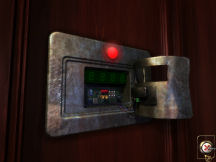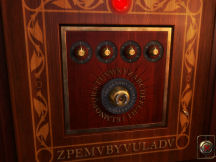What is it?
Well, to
start with, it’s a cool metallic DVD-style box, with a plastic window
showing the CD inside, which looks like the dial of a bank safe. Yes, it’s
SAFECRACKER: The Ultimate Puzzle Adventure. As adventure game
packaging goes, this is one of the best I’ve ever seen. I’ve got to wonder
though, if it caused Customs any second thoughts if they X-rayed it, given
the recent (as in August 2006) security alerts in UK airports. ;-)
The game
itself installed easily, as I find is normal for The Adventure Company
games. Furthermore, as is also normal for The Adventure Company games,
SAFECRACKER plays without the CD in the drive, which is just as well
on my laptop, as the CD drive does tend to get a little heated with
extended use. Unusually for me, I decided to try this game on my laptop,
as it has no difficulty meeting the minimum requirements.
Is there a plot?
There is a
story behind this game, and it’s a simple one: Duncan W. Adams, the
eccentric billionaire recluse, has died, leaving his will hidden somewhere
in his mansion. Given his obsession with safes and locks of all sorts, the
problem for Adams’ estate is that the will lies behind a series of some 35
safes. And you’re the expert safecracker that’s been brought in to solve
the problem. So you’re dropped in the entrance hall of the mansion with
nothing but your wits and a locked door ahead of you.
There is a
bit of a subplot about the various family members that are hoping to
inherit Adams’ fortune, but it’s very lightly played until you hit the end
of the trail.
How do you play?
You
remember how all those game reviewers of the last ten years have been
claiming that point-n-click pre-rendered games are old hat and a dying
breed? Well, SAFECRACKER uses exactly that interface to drive this
game. No fancy environmental animations, no extraneous actors parachuted
in to add ‘character interactions,’ just a 25-room, three-storey mansion
rendered well in ‘bubbles,’ like Myst III Exile. Movement is achieved by
left-clicking when the mouse pointer is pointing forwards; puzzles and
other items are examined by left-clicking when the mouse pointer is a
magnifier. Right-clicking at any time will bring up the inventory and the
menu button, although the menu is also available by pressing Esc.
Outside of
the game itself, there is a simple menu with the usual Save, Load and New
Game and Options. There is not much to tweak in the Options – mostly sound
volume, mouse speed, and whether the voice-overs have subtitles. There are
unlimited save slots for each of five players, each identified by a
different key, and the slots are identified by date and time and a small
screen shot.
So, we know
what the environment looks like, what about the all-important safes?
As I’ve
already mentioned, there are about 35 safes in the game depending upon how
you count them (there is at least one composite safe that might be
described as four separate ones). The puzzle types vary from simple keys
and switches, through passcards, combinations, path-finding mazes, various
ciphers and number puzzles, all the way up to, in my opinion, the hardest
of all: a variation upon the old sliding tiles puzzle. I normally don’t
have any difficulty with sliding tiles puzzles, but this one is really
nasty. In fact, I must admit, I had to resort to a walkthrough to solve
it. A handy feature is that whenever you leave a puzzle unsolved (by
clicking on a nice big red ‘X’ button in the bottom right corner of the
screen), the puzzle resets completely. So if you get a puzzle into a
dead-end, you can just reset it and try again.
As you’d
expect, several of the safes simply require you to find the right numeric
combination, that you then dial or type in. But others require much more
logic. All in all, there are a decent variety of puzzles, all well
designed and clear. Some puzzles require some working out as to what the
objective is. However, if you make a number of false starts or re-start a
puzzle a few times, the narrator gives a clue that usually gives you a
decent idea of where you’re aiming. All of the puzzles are very clear
about whether you’ve succeeded or not – success is simple: the door (in
whatever form) opens with a nice satisfying chime.
My one
complaint about the safes is that although you are not forced to do the
safes in a particular order, the really difficult slider puzzle comes at a
point early in the game beyond which you have to solve the slider
to progress further (unless you can figure out one of the other puzzles
without the clue hidden in the slider safe). Some safes provide access to
new parts of the mansion, others provide keys, and the rest provide hints
that can be used to solve other safes around the house. And it’s usually
quite clear, once you’ve seen the relevant safe, as to which clues apply
to which safes.
Scattered
around the house you’ll also find snippets of information that tell you a
little about Duncan W. Adams and his descendents, in the form of newspaper
articles, notes by D. W. A., letters and postcards from various people,
and pages from D. W. A.’s own diary. This is the vehicle through which the
subplot about the destination of the inheritance to which I alluded
earlier is played out. But as I already said, it’s not an important part
of the gameplay; that’s the safes, of course.
Conclusions
To be
frank, there is not a lot about SAFECRACKER that is actually novel,
except that they’ve put together a game that is almost completely centred
on the puzzle element of adventure games. Yes, it’s in a nice environment.
Yes, the voice acting, what little there is, is perfectly fine. You can’t
die. You can save at any time. There are no sound-based puzzles, or
puzzles that require the differentiation of subtle colours (with one quite
easy exception), nor puzzles that require extraordinary feats of memory or
mathematics. The music is okay, though it becomes repetitive after a few
hours. There is little plot, but the game doesn’t need one. And notably, I
had no technical issues with the game whatsoever – a relative rarity these
days. There is some replay value in SAFECRACKER, but not a great
deal, as the puzzle solutions are almost universally the same every time
you play the game. In fact I can only think of one puzzle whose solution
is randomised each time you play.
So,
finally, with the exception of the sliding tile puzzle I mentioned, I was
able to complete SAFECRACKER in a few hours. I would say it’s a
nice diversion, but not a game that is going to set the world alight.
Grade:
B
What do you need to play it?
Minimum
Requirements
-
Windoes 98SE/ME/2000/XP
-
Processor: Pentium III/AMD Athlon™ 800 MHz
-
Memory: 64 MB RAM
-
Sound Card: DirectX® 9.0c Compatible
-
CD/DVD-ROM: 16x CDROM
-
Hard Disk: 700 MB Available
-
DirectX® 9.0c (Included on CD)
-
Graphics Card: 64 MB DirectX® 9.0c Compatible
(I used a
laptop PC with Win XP Home, AMD Sempron 2800+, 512 MB RAM, and nVidia
GeForce FX Go5200)
9-2006
design copyright ©
2006
GameBoomers
Group



